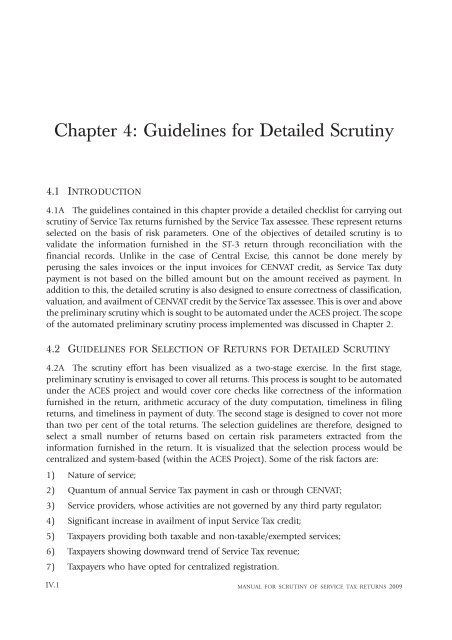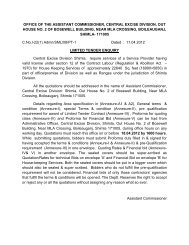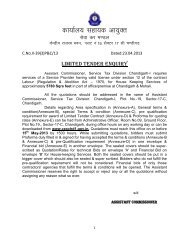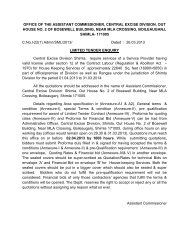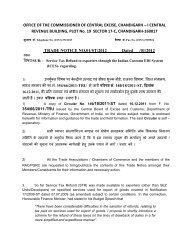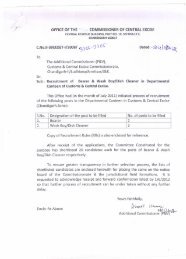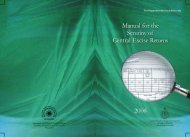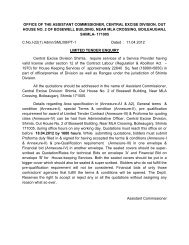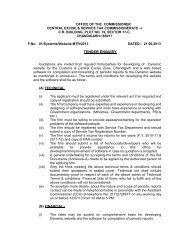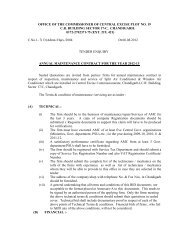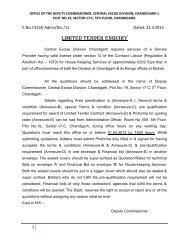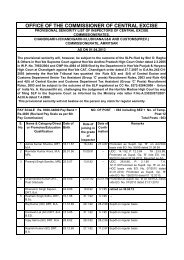Manual for Scrutiny of Service Tax Returns 2009 - Central Excise ...
Manual for Scrutiny of Service Tax Returns 2009 - Central Excise ...
Manual for Scrutiny of Service Tax Returns 2009 - Central Excise ...
- No tags were found...
You also want an ePaper? Increase the reach of your titles
YUMPU automatically turns print PDFs into web optimized ePapers that Google loves.
Chapter 4: Guidelines <strong>for</strong> Detailed <strong>Scrutiny</strong>4.1 INTRODUCTION4.1A The guidelines contained in this chapter provide a detailed checklist <strong>for</strong> carrying outscrutiny <strong>of</strong> <strong>Service</strong> <strong>Tax</strong> returns furnished by the <strong>Service</strong> <strong>Tax</strong> assessee. These represent returnsselected on the basis <strong>of</strong> risk parameters. One <strong>of</strong> the objectives <strong>of</strong> detailed scrutiny is tovalidate the in<strong>for</strong>mation furnished in the ST-3 return through reconciliation with thefinancial records. Unlike in the case <strong>of</strong> <strong>Central</strong> <strong>Excise</strong>, this cannot be done merely byperusing the sales invoices or the input invoices <strong>for</strong> CENVAT credit, as <strong>Service</strong> <strong>Tax</strong> dutypayment is not based on the billed amount but on the amount received as payment. Inaddition to this, the detailed scrutiny is also designed to ensure correctness <strong>of</strong> classification,valuation, and availment <strong>of</strong> CENVAT credit by the <strong>Service</strong> <strong>Tax</strong> assessee. This is over and abovethe preliminary scrutiny which is sought to be automated under the ACES project. The scope<strong>of</strong> the automated preliminary scrutiny process implemented was discussed in Chapter 2.4.2 GUIDELINES FOR SELECTION OF RETURNS FOR DETAILED SCRUTINY4.2A The scrutiny ef<strong>for</strong>t has been visualized as a two-stage exercise. In the first stage,preliminary scrutiny is envisaged to cover all returns. This process is sought to be automatedunder the ACES project and would cover core checks like correctness <strong>of</strong> the in<strong>for</strong>mationfurnished in the return, arithmetic accuracy <strong>of</strong> the duty computation, timeliness in filingreturns, and timeliness in payment <strong>of</strong> duty. The second stage is designed to cover not morethan two per cent <strong>of</strong> the total returns. The selection guidelines are there<strong>for</strong>e, designed toselect a small number <strong>of</strong> returns based on certain risk parameters extracted from thein<strong>for</strong>mation furnished in the return. It is visualized that the selection process would becentralized and system-based (within the ACES Project). Some <strong>of</strong> the risk factors are:1) Nature <strong>of</strong> service;2) Quantum <strong>of</strong> annual <strong>Service</strong> <strong>Tax</strong> payment in cash or through CENVAT;3) <strong>Service</strong> providers, whose activities are not governed by any third party regulator;4) Significant increase in availment <strong>of</strong> input <strong>Service</strong> <strong>Tax</strong> credit;5) <strong>Tax</strong>payers providing both taxable and non-taxable/exempted services;6) <strong>Tax</strong>payers showing downward trend <strong>of</strong> <strong>Service</strong> <strong>Tax</strong> revenue;7) <strong>Tax</strong>payers who have opted <strong>for</strong> centralized registration.IV.1MANUAL FOR SCRUTINY OF SERVICE TAX RETURNS <strong>2009</strong>


